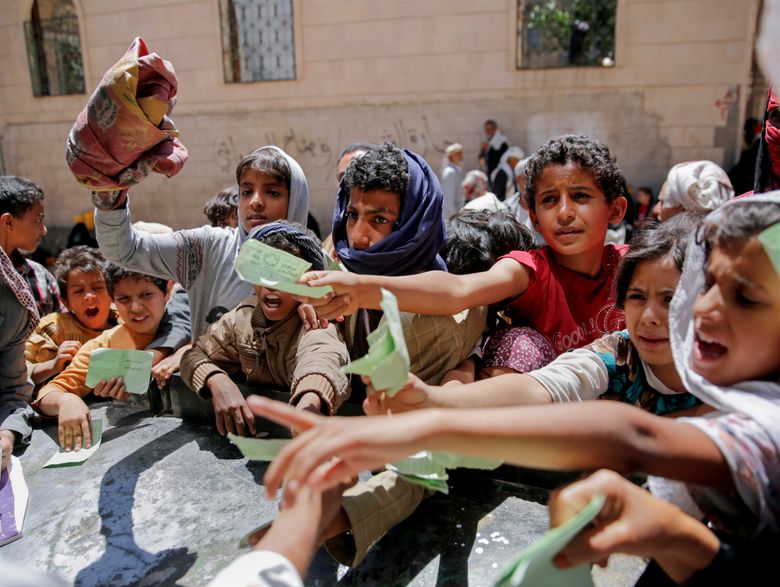
REPORT from UN Office for the Coordination of Humanitarian Affairs
Published on 28 Jan 2018
PDF View: https://drive.google.com/file/d/1CR9kJeIbVUDPj5jISM-xpC3q1rJ976B2/view?usp=sharing
HIGHLIGHTS
- 22.2 million people in Yemen need assistance in 2018 – one million more than in June 2017.
- The 2018 Yemen Humanitarian Response Plan seeks US$2.96 billion to assist 13.1 million people.
- Diphtheria has killed 48 Yemenis in 19 governorates.
- In 2017, the YHF allocated $129 m to 53 partners to implement 111 projects.
The world’s worst man-made humanitarian crisis
Humanitarian needs across Yemen continue to increase, fuelled by ongoing conflict that has collapsed the economy, crippled social services and severely disrupted livelihoods. With more than 17 million – two in three people – not knowing where their next meal will come from, Yemen is the world’s largest humanitarian crisis. According to the 2018 Humanitarian Needs Overview (HNO), an estimated 22.2 million people, equivalent to 75 per cent of the population, are in need of some kind of humanitarian or protection assistance, including 11.3 million who are in acute need - an increase of more than one million people since June 2017. The most severe needs are in areas of ongoing conflict or areas with large numbers of IDPs and returnees.
Some 8.4 million people are severely food insecure and at risk of starvation; a 24 per cent increase since 2017. Some 7.5 million people need nutrition assistance including 1.8 million children and 1.1 million pregnant or lactating women who are acutely malnourished. Five governorates (Al Hudaydah, Lahj, Taizz, Abyan and Hadramaut) have acute malnutrition rates above the emergency threshold set by the World Health Organisation of 15 per cent. Purchasing power and social safety nets for millions of people have been eroded as more than 1.25 million public servants have not been regularly paid their salaries for over a year.
The number of people in need does not include additional needs that were created by the three-week blockade imposed by the Saudi-led Coalition on commercial imports bound to the Red Sea ports of Saleef and Al Hudaydah in November 2017, and the week of intense fighting in the capital, Sana’a, in early December.
10 per cent of all Yemenis have been displaced in the last 30 months
Armed clashes, airstrikes and localised attacks on civilians have taken a devastating toll on the people of Yemen and generated widespread protection needs. About 12.9 million people need assistance to protect their safety, dignity or basic rights, from violations of International Humanitarian Law, grave violations of children’s rights and gender-based violence. From October 2016 to September 2017, almost 8,900 conflict-related incidents, including airstrikes, armed clashes and shelling, were reported throughout Yemen – of which 82 per cent occurred in five governorates: Taizz, Sa’ada, Al Jawf, Hajjah, and Sana’a. More than 10 per cent of all Yemenis have experienced the shock of displacement due to conflict in the last 30 months.
Most of those who have been displaced are struggling to cope because prolonged violence has brought the economy to its knees, exacerbated pre-existing vulnerabilities, degraded community resilience and accelerated the collapse of public institutions. Imports and internal movement of goods have become more difficult due to securityrelated restrictions, with enterprises reducing operating time by a half and laying off more than half of the workforce.
Only 50 per cent of health facilities in 16 governorates are functional, but lack supplies or are manned by health workers who have not received salaries for months. An estimated 16.4 million people require assistance to obtain healthcare – of whom 9.3 million are in acute need.
Education has been disrupted and two million children are out of school. The discontinuation of the payment of teacher salaries has created an education crisis, risking a generation of illiterate children if no mitigation measures are put in place. UNICEF reports that between March 2015 and November 2017, out of 16,000 schools, around 256 schools were reportedly destroyed, 1,413 schools were partially damaged due to airstrikes or shelling while 150 schools were occupied by IDPs and 23 by armed groups. Teachers across the country have not been regularly paid salaries for more than a year.
In most areas of Yemen, WASH systems have been severely disrupted due to shortages of fuel to power them or lack of maintenance by public institutions. As a result, an estimated 16 million people need assistance to access to safe water, basic sanitation and hygiene facilities. Inadequate access to water and proper sanitation contributed to a spike of more than one million suspected cholera cases reported in 2017. In terms of shelter, an estimated 5.4 million people need emergency shelter or essential household items, including IDPs, host communities and initial returnees.
UN Office for the Coordination of Humanitarian Affairs:
To learn more about OCHA's activities, please visit http://unocha.org/.






0 Comments